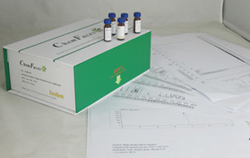Hot Products



| Catalog No. | Information |
| CFN99929 | Morin Morin, a α-glucosidase inhibitor with an IC50 value of (4.48 ± 0.04) uM, it also exhibits inhibition in the generation of advanced glycation end products which was related to the long term complications of diabetes. Morin has anti-inflammatory and anti-oxidative effects by activating Nrf2 signal pathways and inhibiting NF-κB activation. it can be used to prevent bladder cancer, it prevents MMP-9 expression via the inhibition of transcription factors AP-1, Sp-1, and NF-κB. |
| CFN70420 | Morindin Reference standards. |
| CFN89445 | Moringin Moringin is a modulator of neuroinflammation via the β-catenin-PPARγ axis, it can activate Wnt canonical pathway by inhibiting GSK3β in a mouse model of experimental autoimmune encephalomyelitis. Moringin is effective in inducing apoptosis through p53 and Bax activation and Bcl-2 inhibition, it demonstrates the antitumor efficacy in human malignant astrocytoma cells. The combination of cannabidiol and moringin has anti-inflammatory, antioxidative, and anti-apoptotic effects. |
| CFN89187 | Morolic acid Morolic acid and moronic acid have shown sustained antidiabetic and antihyperglycemic action possibly mediated by an insulin sensitization with consequent changes of glucose, cholesterol and triglycerides, in part mediated by inhibition of 11β-HSD 1. Morolic acid exhibits pronounced radical scavenging activity against the stable 2,2-diphenyl-1-picrylhydrazyl radical and is a potent inhibitor of neutrophil elastase and cyclooxygenase-1 and -2 in vitro. Morolic acid has anti- inflammatory activity, it can inhibit leukotriene B4 production in rat polymorphonuclear leukocytes stimulated with calcium ionophore A 23187. Morolic acid exhibits promising anti-HIV activity, it also exhibits moderate inhibitory activity against glycogen phosphorylase. |
| CFN97145 | Moronic acid Moronic acid shows oral therapeutic efficacy in HSV-infected mice and possessed novel anti-HSV activity. It also shows significant anti-HIV activity (EC(50) 186) and was modified to develop more potent anti-AIDS agents. Moronic acid is a new structural lead for anti-EBV drug development, can substantially reduce the numbers of EBV particles produced by the cells after lytic induction. Morolic and moronic acids have shown sustained antidiabetic and antihyperglycemic action possibly mediated by an insulin sensitization with consequent changes of glucose, cholesterol and triglycerides, in part mediated by inhibition of 11β-HSD 1 as indicated by in vitro. |
| CFN98161 | Morroniside Morroniside has therapeutic effects on diabetic angiopathies, renal damage, lipid metabolism and inflammation and bone resorption. Morroniside can notably protect the brain from damage induced by focal cerebral ischemia which might be related to morroniside antioxidant and anti-apoptotic properties in the brain.Morroniside can decrease the level of cycloxygenase(Cox) and it may be the mechanism of morroniside on inhibiting the platelet aggregation induced by ADP in rabbits. |
| CFN97083 | Morusin Morusin exhibits antinociceptive, analgesic, anticonvulsant, antibacterial, and antitumor activities. Morusin can inhibit NF-κB and STAT3 activity, activate caspases activity, and restorate GABA level. |
| CFN97086 | Morusinol Morusinol may significantly inhibit arterial thrombosis in vivo due to antiplatelet activity, may exert beneficial effects on transient ischemic attacks or stroke via the modulation of platelet activation. |
| CFN93148 | Moscatin Moscatin exhibits antiplatelet aggregation activity. |
| CFN94006 | Moschamine Moschamine is a very potent compound that is able to inhibit COX-I by 58% and COX-II by 54%, at the concentration of 0.1 μmol L⁻1, it may suppress cAMP formation via binding to 5-HT1 receptors in the cells. Moschamine exerts antitumour effects on HeLa, MCF7 and A431 cells. |